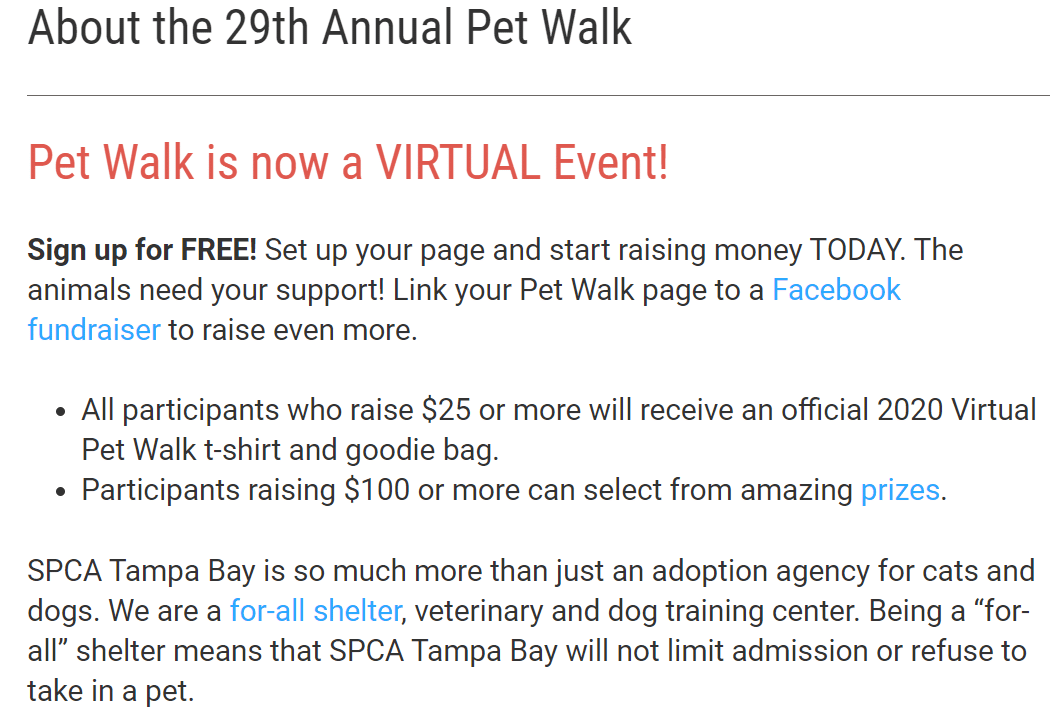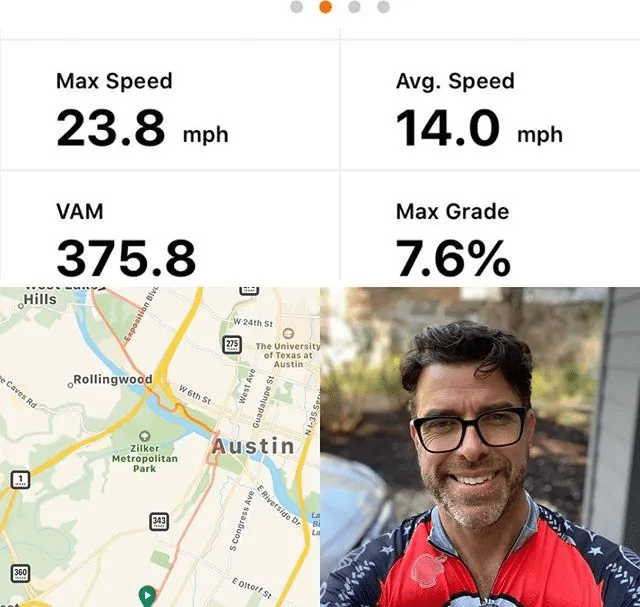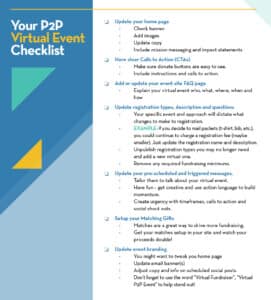How to Take Your Peer-to-Peer On-the-Ground Event Virtual: 9 Tips to Pivot Your Event
Hosting a run, walk, ride or other on-the-ground event is a powerful way to bring people together in a shared and memorable experience, remind current supporters they make a difference, and educate and inspire people about your mission. And, it’s an effective way to raise dollars for your cause!
When natural disasters, severe weather or other unforeseen circumstances like COVID-19 prevent you from hosting your on-the-ground event, one option is to take your fundraising virtual.
Taking your peer-to-peer event virtual allows you to engage participants and supporters online, in fun, new and creative ways that motivate, and if executed correctly, can drive more fundraising.
This complete guide will walk you through all of the necessary steps of the peer-to-peer virtual event planning process, plus extra tips and resources to get you on your way fast and avoid common pitfalls.
Here are the 9 tips we’ll cover:
- Rally staff and board members
- Create compelling communications
- Fire up VIPs and influencers
- Create your virtual fundraising site
- Add gamification to engage and raise more
- Motivate participants with rewards and recognition
- Involve corporate sponsors and major donors
- Recognize and thank your participants
- Don’t Stop! Keep fundraising year-round with DIY events
For specific tips around one of these topics, use the links above to jump to the section you need. Or follow along with us from the top! You’ll be raising more and fundraising online in no time.
Let’s get started!
Rally Your Staff and Board Members
In most cases, going virtual is a great approach, as it offers a wide variety of online fundraising options and flexible timeframes, with little on-the-ground costs. Even if you are simply postponing your peer-to-peer event to a later date, online fundraising can be a bridge fundraising strategy to help you raise revenue until event day.
The first thing you need to do is rally your team! Before you get too far into the planning process, determine who’ll be in charge of the different components of your virtual fundraising event.
- Start with your leadership team
- Enlist dedicated board members
- Activate your loyal supporters
- Recruit staff from outside the fundraising team
Be sure to recruit a virtual campaign leader(s). Having a leader(s) can keep your team on the right path to accomplish your goals.
Create Compelling Communications
Once your team is assembled and on board, it’s important to communicate to your registered participants about the change.
Going virtual with your peer-to-peer virtual fundraising software becomes a great opportunity for nonprofits to open up their fundraising to remote supporters across the country. It’s also a way, thanks to social media and social networks, to attract new supporters to your cause.
Best practices to communicate your change of plans:
- Email registered participants about your change of plans.
- Be clear, concise, and confident.
- Let them know how much you appreciate their support and how they can help.
- Email donors in your campaign.
- Thank them for their support and let them know the event is going virtual and how much their donation matters, especially right now.
- You just might find that some of them will give a second donation to the participant or team they support.
- Ask them to spread the word on social media. Virtual campaigns get a big boost from leveraging social networks and attracting new supporters.
- Update your website with the latest about your cause and continued fundraising efforts.
- Update home page banner.
- Update event page(s) with new event information.
- Change any callouts on other website pages.
- Date your updates so supporters know they have the latest information.
- Update your COVID-19 Response Page with the latest about your peer-to-peer event plans and a link to your virtual event site.
- Blast social media about your change in plans.
- Provide regular updates on your progress on your social channels.
- Link back to the virtual event site.
- Tag peer-to-peer participants, ambassadors, and other social influencers.
- Attract new social donors and networks to your cause.
- Give a shout out and tag corporate sponsors!
- Pick-up the phone and get creative with and tried and true format.
- Create a recorded message to your phone system.
- Make personal outreach calls peer-to-peer participants, including captains and prior top fundraisers.
- Create or update your organization’s Email signature.
- Add an announcement about your virtual peer-to-peer event
- Include a link to your virtual event site
- Create a video with a personalized message.
- Provide an extra personal touch from your CEO or Executive Director
- Link to it in emails, social media posts, and your email signature
- Embed it on your virtual peer-to-peer event site
Content is key! Be specific and concise with the changes you are making and what you are asking people to do.
Here’s a great example of the messaging SPCA Tampa Bay used to take their pet walk virtual:

Fire Up Your VIPs and Influencers
This is the time to give extra attention to your team captains, top participants, and volunteers and engage them to support you through this change. These are your leaders and influencers, and they will want to help you make this pivot and reach or exceed your fundraising goal.
Here’s a few best practices for firing up your VIPs and participants:
- Provide Tools & Templates. One of the best ways to motivate participants and VIPs to fundraise out of the gate is to supply them with social media and email templates to make it easy to share about the campaign. Ease is a top motivator for today’s Social Fundraisers.
- Recognize Supporters. Your participants and VIPs work hard to promote your cause and your peer-to-peer virtual campaign, so don’t let their dedication go unnoticed. Always thank participants (and donors) on an individual level, communicating your appreciation and outlining the potential impact of their donation. On a public level, show your gratitude by highlighting participants and sponsors on your social media channels and microsite.
- Inspire Competition. Everyone’s a winner during a peer-to-peer virtual campaign. Liven up your fundraising by incorporating friendly competition. Tools like leaderboards and fundraising thermometers will inspire fundraisers to go the extra mile, and inject an element of competitive fundraising that is sure to help you reach or exceed your goals.
- Take An Active Role. Deepen engagement with participants by taking an active role in your campaign. Offer donation request templates, provide campaign support, and acknowledge your fundraisers’ success along the way – especially when they and you hit key virtual fundraising milestones.
Other creative ideas for giving VIP treatment:
- Host a group video call to let them be the first to know about your plan and clearly ask what you need from them. Make them part of the process and thank them for their support.
- Make personal calls during the fundraising period to check in and provide encouragement.
- Have something fun delivered to them to thank them for “going the extra mile” to help make the virtual event a success.
- Give shout outs on social media to recognize and thank them for all they are doing.
Create Your Virtual Fundraising Site
Once you’ve made the decision to go virtual, you’ll need to modify the messaging and registration options for your peer-to-peer event. You might also consider updating the branding for your event to emphasize that your event has gone virtual.
Here’s what SPCA Tampa Bay did for their Pet Walk:

Your P2P Virtual Event Checklist:
-
Update your peer-to-peer event site home page.
- Check banner
- Add images
- Update copy
- Include mission messaging and impact statements
- Have clear calls-to-action (CTAs).
- Make sure donate buttons are easy to see.
- Include instructions and calls-to-action.
- Add or update your event site FAQ page.
- Explain your virtual event who, what, where, when and how.
- Update registration types, descriptions, questions, and defaults.
- Your specific event and approach will dictate what changes to make to registration.
- If you decide to mail packets (t-shirt, bib, etc.), you could continue to charge a registration fee (maybe smaller). Just update the registration name and description.
- If you keep your registration fee, consider treating part of it as a donation.
- If you’ve already taken registrations and want to make changes to existing registration types, don’t delete them. Edit them or unpublish them and add new ones. That way you’ll keep your data intact!
- If you haven’t opened registration, delete the registration types you no longer need and add new ones.
- Update default personal messages and fundraising goals for participants and teams.
- Consider removing or reducing required fundraising minimum and focus on motivating more fundraising and engagement instead.
- Update your pre-scheduled and triggered messages.
- Tailor them to talk about your virtual event.
- Have fun – get creative and use action language to build momentum.
- Use them to encourage and thank participants.
- Create urgency with timeframes, calls-to-action, and social shout outs.
- Add Promotions, including Matching Gifts.
- Matches are a great way to drive more fundraising.
- Get your matches setup in your site and watch your proceeds grow exponentially!
- Customize your Leader Boards with rewards and recognition for top finishers.
- Incorporate Contests, Competitions, or Drawings along the way to motivate even more fundraising.
- Update event branding.
- You might want to tweak your home page banner and other images.
- Update your email banner.
- Adjust copy and info on scheduled social posts.
- Don’t forget to use the word “Virtual Fundraiser”, “Virtual P2P Event” to help stand out!
Add Gamification to Engage and Raise More.
You can add fun and meaningful activities to engage participants, to feel connected to one another and your cause, and to ultimately help drive the success of your peer-to-peer fundraising. With a virtual event, it’s even more important to involve participants in doing things that remind them why they joined so they feel confident asking for donations. If you already included a “virtual participant” registration option in your event, that’s great! Now all participants can be part of the online engagement.
Here are 5 best practices to drive online engagement:
- Ask participants to complete activities leading up to your virtual event day, such as: keep a journal to share their training progress with photos or videos, share a photo of a favorite memory from a previous year, or share a video of why they are participating or who they are honoring.
- Ask participants to show completion of an activity on your virtual event day with a photo, video or blog post. This could be the event activity (run, walk, ride, etc.) they do on their own or a favorite activity of the person they are honoring. Posts made to participant pages are easily shared on social media and automatically include your event hashtag and a link back to the participant’s page. All the photos and videos will automatically populate your gallery and timeline, and the social posts will help amplify your virtual event.
- Give participants the option to complete fitness challenges leading up to your virtual event day to earn points. They can log their progress with a photo, video or blog post with an update on their progress and easily share on social media.
- Give participants a recruiting challenge to successfully get 3 friends to join to earn recruiting points. You could even have a special drawing to include everyone who has recruited at least 3 people.
- Let your participants create Facebook Fundraisers that integrate with their participant page. Just one more way to drive more donations and amplify your event!

Motivate Participants with Rewards and Recognition
Motivation & Rewards can provide that extra push to keep the fundraising efforts going strong. For your virtual peer-to-peer event you can still use merchandise/incentives as an incentive!
Remember to highlight your social fundraisers when they hit campaign milestones, recognition is a strong motivator. Reward them with branded t-shirts or other cool swag. Use badges and digital achievements to recognize virtual fundraising and social reach!
- Use daily, weekly or monthly drawings to reward participants for recruiting, completing activities, social sharing, or fundraising.
- Use weekly fundraising contests to give all participants a chance to make a leaderboard based on who can bring in the highest donation total or number of donations during the week.
- Tip: Adding a match day during the contest week really boosts fundraising!
- Create head-to-head competitions to match up sets of high-performing and competitive teams to compete during the final fundraising stretch.
- Set up triggered messages and badges to encourage and thank participants as they reach new levels of achievement.
Involve Corporate Sponsors and Major Donors
Corporate sponsorships are a great way for nonprofits to bring in additional revenue for their virtual events and campaigns without additional overhead or costs.
Corporate sponsorships are a dollar-for-dollar exchange – and one that can really benefit their brand awareness and your fundraising goals.
A few must-dos when securing your peer-to-peer virtual event sponsors:
- Ask your sponsors to provide tangible prizes or other rewards for your contests, drawings, and leaderboard winners and promote these on your event site and leaderboard page.
- Use large donations from corporate sponsors or major donors to offer a matching gift day. They get recognition with an entry in the timeline each time a donation is made as well as on the participant and team pages. Matches give participants extra incentive to fundraise and donors extra motivation to give.
- A large donation from a corporate sponsor or major donor can also be used for a photo or video match. This will encourage participants to share compelling content on social media, furthering your reach and providing recognition to these generous donors.
- To encourage participation by corporate sponsor employees, in addition to providing a special discount code to register, create corporate group pages so that individual participants and teams from the company can see their collective impact and engage in a friendly competition.
- Using our built-in geolocation, ask participants to visit specific locations and capture a photo or video. This is a great way to drive engagement with your corporate sponsors who have physical locations, such as restaurants or retail stores. (Of course, during a pandemic like the Coronavirus, this option isn’t advisable.)
Recognize and Thank Your Participants
Just as you were planning to do with your on-the-ground event, be sure to thank your participants along the way and at the conclusion of your fundraising.
Here are ideas for recognizing and thanking participants:
- Give shout outs on social media about your progress and the impact of the funds raised. There’s no doubt that you’ll have plenty of photos, videos, and stories to share that are funny, inspiring, or moving.
- Send out an email the day after fundraising concludes to everyone that played a role in your success. Share the final numbers, the impact made, and a link to share feedback.
- Consider creating a video with photos and video clips set to music, including thank you’s from your staff and the final results and impact. You can do something quick a simple using your mobile phone or use an easy-to-use video tool like Animoto or WeVideo.
- After fundraising wraps up, host a special virtual celebration via Zoom, Facebook Live, or other livestream to give thanks to your top fundraisers and teams.
Don’t Stop! Keep Fundraising Year-Round with DIY Events
You have supporters who want to help you – especially through difficult times. Be sure you are offering other online and virtual ways for them to get involved – to donate to you, fundraise for you, volunteer, advance your mission through specific activities they can do on their own, and spread the word about your mission.
Consider launching year-round peer-to-peer campaigns, including: a DIY/Fundraise Your Way campaign, a Memorial/Tribute campaign, or a Donate an Occasion campaign.
Final note about going virtual vs. postponing your Peer-to-Peer event:
In most cases, canceling your on-the-ground event and going virtual is the right approach, but there may times when postponing your on-the-ground event makes more sense. However, even if you postpone, you can still keep your fundraising open and engage your participants online in fun, new ways until your event.
Wrapping Up!
More fundraising resources are just a click away.
- 2024 Fundraising Outlook Study: Learn where nonprofits plan to invest their time, effort, and technology budget in the coming year.
- 9 Tips for Recruiting Peer-to-Peer Participants: Proven tips to help your nonprofit recruit and retain more peer-to-peer participants.
- 12 Tips to Rock Your Next Run, Walk, or Ride: By following these tips, you can make a profitable impact for your nonprofit and create lasting memories for your supporters.



